-
Publish Your Research/Review Articles in our High Quality Journal for just USD $99*+Taxes( *T&C Apply)
Offer Ends On
Aru Johncharles*, Ebyiau Johnnie, Adikini Scovia, Kakeeto Ronald, Omaria Samuel, Emanio John and Rojers Collins
Corresponding Author: Aru Johncharles, National Semi-Arid Resources Research Institute (NaSARRI), P.O. Box 56, Soroti-Uganda.
Received: May 15, 2025 ; Revised: June 03, 2025 ; Accepted: June 06, 2025 ; Available Online: July 08, 2025
Citation: Johncharles A, Johnnie E, Scovia A, Ronald K, Samuel O, et al. (2025) Registration of Titan and Temani16h High Yielding Sorghum Hybrid Cultivars with Marketable Grain Qualities for Enhanced Utilization in Uganda. J Agric For Meterol Stud, 4(1): 1-13.
Copyrights: ©2025 Johncharles A, Johnnie E, Scovia A, Ronald K, Samuel O, et al. This is an open-access article distributed under the terms of the Creative Commons Attribution License, which permits unrestricted use, distribution, and reproduction in any medium, provided the original author and source are credited.
Views & Citations
Likes & Shares
Climate smart agriculture includes good farming practices and introduction of high yielding sorghum varieties that are adapted to specific regions to enable farmers who have exhausted the potential of the traditional varieties attain maximum grain yields. Two sorghum (Sorghum bicolor (L.) Moench) hybrids registered as; TEMANI16H (12GS9022) and TITAN (12GS9051)) were developed by Texas State University in the U.S.A and introduced in to Uganda by our partners of AGRODYMICS seed Limited. Registration trials were conducted in 2019A and 2019B by the National Semi-Arid Resources Research Institute (NaSARRI)-Serere, to confirm their adaptability since they were bred from different gene pools. This was through evaluating in ten environments alongside 2 commercial open pollinated check varieties. These hybrids were selected for release based on their agronomic desirability, unique grain quality traits and high yield potential with better adaptation to dry lowland and sub humid agro-ecologies. Heritability for key yield components such as; grain yield, seed size and panicle length were high indicating that they are genetically buffered against environmental variations. The hybrid cultivars have cytoplasmic male sterility background and will enter commercial production once registered in Uganda to make hybrid seed production and marketing easy.
Keywords: Sorghum bicolor, Hybrids, Grain quality, Yield potential, Adaptation
INTRODUCTION
Following government drive on commercialization and agro-industrialization, sorghum (sorghum bicor) has entered in to export trade within the east African region (EAC) and China. The old varieties that have been traded locally have to be supplemented and complemented with new adapted cultivars that match the current changes in production environments, while possessing new set of traits for commercialization with adequate competitiveness required in the global market. And, deployment of robust hybrid cultivars that incorporate stress-related traits such as (Stay green, long panicle, well exerted, large seed size and early maturity) is critical to improve yield performance in sorghum [1]. Since these hybrids were bred from different gene pools, a thorough and comprehensive assessment of their adaptation and value for use and cultivation is necessary. Resistance, grain yield and seed quality are complex traits affected by several interacting plant and environmental factors [2]. These data aids cultivar registration making a valuable addition to the supply chain and to the breeding programme through perceived contributions such; as earliness, reduced height and improved grain yield. This is the second cohort sorghum of hybrids to get in to the variety release catalogue in Uganda for commercialization.
MATERIALS AND METHODS
The two candidate sorghum hybrid cultivars were developed using A2 cytoplasmic system of male sterility with male parents as pollinator. They were evaluated alongside two commercial varieties from Uganda and advanced breeding lines introduced by ICRISAT from Ethiopia. Evaluation was conducted under sub humid and semi-arid dry lowland areas representing northern savannah, eastern agro-ecologies and Lake Basin zones of Uganda. Trials were laid in Randomized complete Block design, replicated three times with plot size of 5m by 2.4m and data was collected on all the four rows. Multilocational trials were analyzed by season in each location and by location, using analysis of variance to test the significance of cultivar effect. A combined analysis of variance across locations was carried out to test the significance of differences in locations, genotype and location x genotype interaction effects [3]. Participatory variety selection (PVS), was conducted in 2019b during field days using a total of 120 people (60 males and 60 females). They were drawn from districts of; Serere, Kumi, Lira, Oyam, Iganga and Mayuge. Farmer’s assessment from participatory variety selection was summarized in to contingency table based on frequencies. The sample of ten males and ten females were selected from Serere district based on convenience to promote discussion in order to enhance the quality of the feedback from participatory variety selection according to Parker & Tritter [4]. Grain quality analysis for key bio-chemical components that influence food quality and nutrition was conducted in Namulonge national agricultural research Institute bio-nutrition laboratory. The analysis included; crude proteins, condensed tannins, phenols and starch (Table 1).
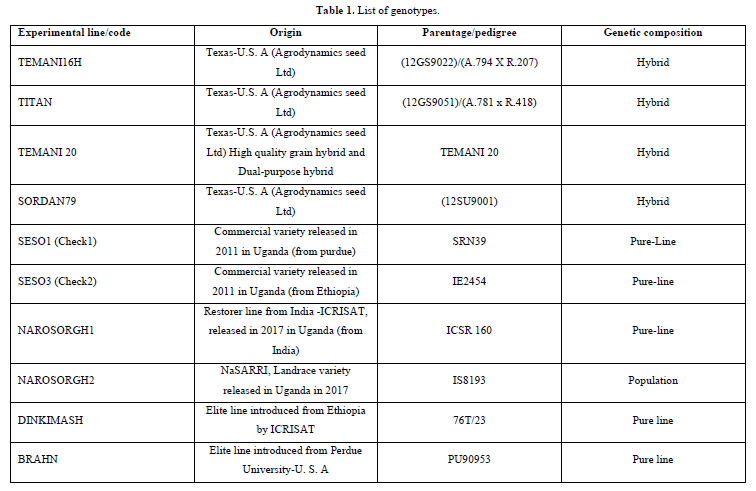
DATA COLLECTION
Data was collected on days to 50% flowering, plant height, shoot fly, stem borer incidence, smut incidence, Striga emergence counts per M2, agronomic acceptability and grain yield. The percentage pest and disease incidence in hybrids was compared with the commercial varieties during the growth period. Data on shoot fly incidence was collected at 3rd week based on % of dead hearts. For spotted stem borer (Chillo partellus), from 11th week after planting (at soft dough stage). Where <30% dead heart incidence qualifies a genotype to be resistant that is; 1 to 2 leaves with leaf eating symptoms of <50mm2. Striga and smut were evaluated in hot spot locations under natural infestation in Kumi and Iganga with the participating farmers. Assessment of covered kernel smut incidence was done at physiological maturity when grains are fully matured based on 0-5 scale [5]. As follows: 0% incidence=Immune, 1-10% incidence = Very resistant, 11-25% incidence= moderately susceptible 26-50% incidence= susceptible, 51-100% incidence=very susceptible. Striga assessment was based on both Striga counts per M2 and Striga vigor on 1-9 scale developed by ICRISAT during field evaluation trials and modified rating by Lanen (2007). This scale reflects host insensitivity to striga driven toxin. Striga count infestation data was transformed as (X=√(X+0.375) according to Ramaiah [6]. The 1st striga data was collected at 50% flowering, then at two weeks interval up to harvest. A test entry must show 10% less striga count than the adjacent check plot in the unit to qualify to be resistant [7]. SESO1 variety (SRN39) was used as check for striga because is known for multiple resistance and accounts for broad resistance [8].
Site characteristics (Table 2)

STATISTICAL METHODS AND DATA ANALYSIS
Descriptive statistics for parameters used. To determine stability of performance of genotypes across range of environments on quantitative traits, varietal ranks at different locations and seasons indicated presence of genotype by environment interactions. Since this interaction reduced the correlation between the phenotypic and genotypic values it precluded the use of genotype means alone in selecting stable genotypes. The analysis of variance tests considered the corresponding expected mean squares under the corresponding main effects and interactions. Generalized linear mixed models were used for analyses of variance and regression analyses. Pairwise correlation matrix was used to test how female and men perceive the traits of new varieties for optimal utilization of the technology and was calculated from pooled data.
RESULTS AND DISCUSSION
Parameters and traits of agronomic interest
Multi-environmental trials (METs) were performed to quantify the magnitude of genotype × environment interaction and to recommend varieties with narrow or broader adaption [9]. Genotype by environment interaction (G×E) is a differential response of genotypes when grown across environments [10]. Data analysis for each environment was performed and combined analysis of variance using GENSTAT 17 statistical package. The GGE biplot and AMMI analysis [11] for identification of stable sorghum genotypes. The AMMI analysis of yield performance in kg/ha of sorghum genotypes evaluated in ten locations across two seasons in Uganda 2019A and 2019B, is presented (Tables 3-5). The presence of significance of genotype by location (G*L), justified partitioning of test locations and the distribution presented in the scatter plot (Figure 1). The polygon view of the GGE biplot explained 66.7 % genotype by environment variation for grain yield.
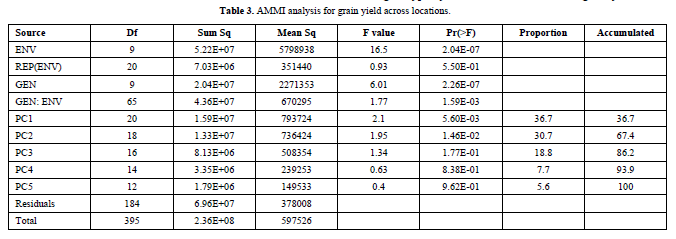

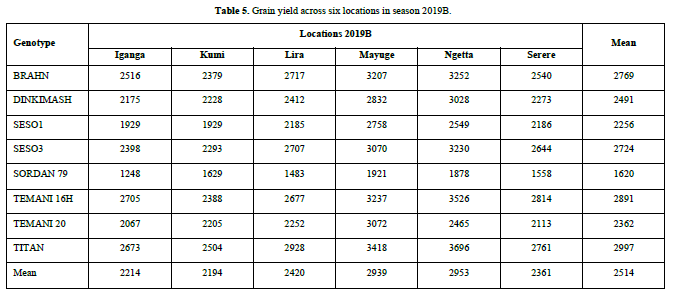
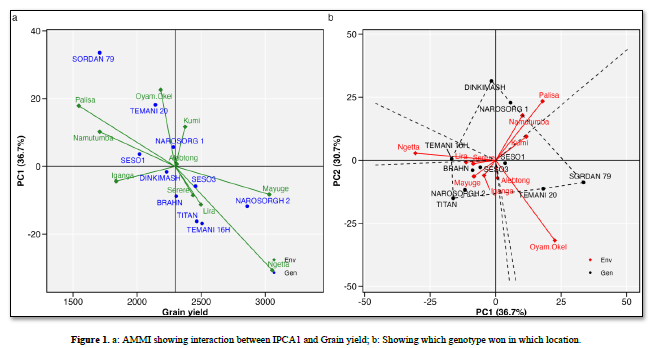
Hundred seed weight in this study was moderately controlled by genetics accounting 28% of the variation and environment accounted for 36.2% of the total variation. Therefore, better management of environmental variables is critical in ensuring high grain productivity. Average seed size was 2.7gms per 100 seeds. This is most important character on which to base hybrid cultivar selection and offers great scope for improvement for grain qualities (www.LSUAgCenter.com). Grain size greater than 2.7 gms /100 seed mass could make good grain composites because of large volume is occupied by the endosperm (food reserve). This contributes to early seedling emergence and establishment, hence profitable sorghum production. Other contributing factors to hybrid seed production are long exertion, long panicle and width medium /early maturity, short statured nature with lodging resistance (Table 6 & Figure 2A-2D).
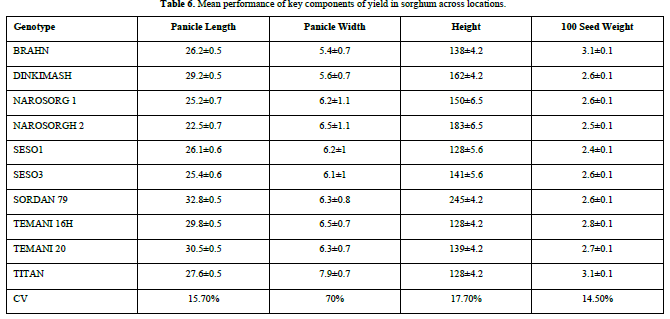
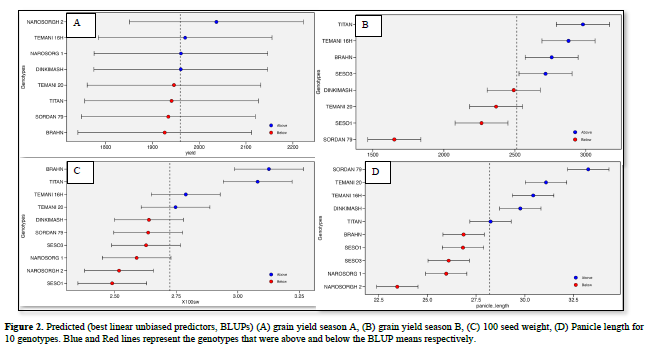
Stability and ranking of genotypes based on grain yield across two seasons
By performing environment centered and genotype focused GGE Bi-plot analysis, the stable varieties were identified as; NAROSORGH2 > TEMANI 16H > TITAN > SESO 3 > BRAHN (Figure 3).
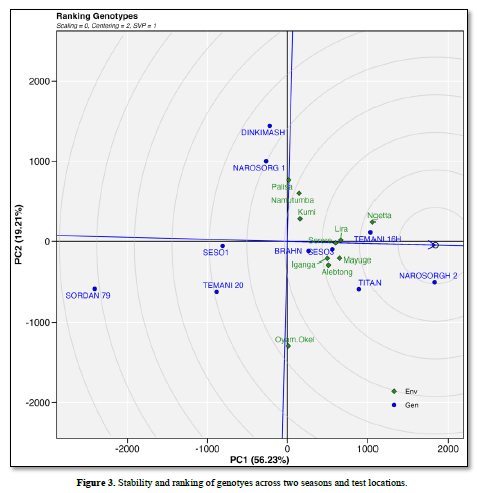
Broad Sense heritability (BSH) for grain yield
The variance components were used to estimate broad sense heritability (H2) using the model; Any Observation = Population Mean +Genotype+ Environment +Genotype*Environment +Error term. The genotypes were a treated as fixed effects and all other terms as random with reps nested within environments. Locations as random effects was applied as suggested by Mclntosh [3] and by Moore and Dixon [12]. Parameters and corresponding variance components in the mixed model correspond to specific main effects or interaction effects. The analysis of variance tests was motivated by consideration of the corresponding expected mean squares under the corresponding main effects and interactions. BSH on entry mean across environments for grain yield was 91% on single plot basis. Dominance gene effects are strongly exhibited at F1 due heterosis for physiological and morphological traits contributing to tolerance to stresses. Physiological traits positively influenced may include; plant vigor, stay green and other traits related to components of the plant cell. However, this yield advantage that is contributed by non-additive gene effects can better be achieved, if hybrids are grown in fertile places and environment is well managed through application of fertilizers to exploit the strong the GxE interaction effect on yield components.
Regression of grain yield of a Hybrid cultivar over a popular commercial variety:
Regression of superior hybrid TEMANI 16H on SESO 3, was given by the equation y=896.1 + 0.73x, where 896.1 kg is yield advantage. Farmers should therefore be encouraged to adopt sorghum hybrids to supplement their grain yields. Yield difference 896 kgs /ha is 30% grain yield benefit. Yield advantage of 10-15 % is recommended for release of hybrid without use of fertilizer.
Components of grain quality for alternative utilization niches in agro- allied industries
Several traits and qualities are shown to be correlated with particular novel end uses in food, feeds and soft drinks value chains as well as local brew (Table 7).
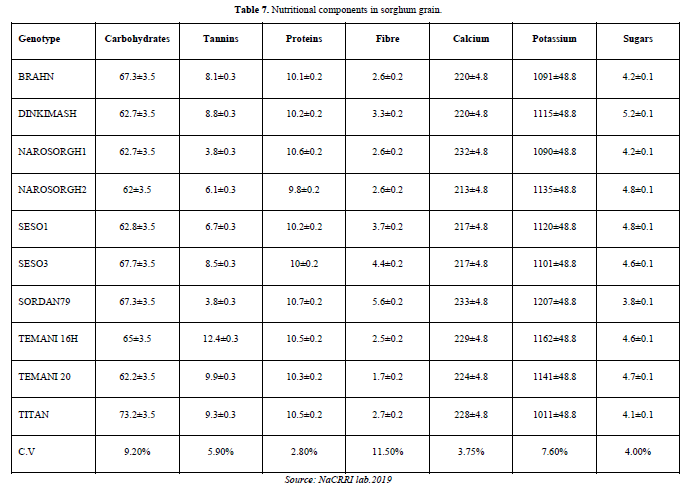
Smut incidence was recorded by establishing the proportion of sorghum plants showing symptoms to kernel covered smut over the total number of plants and expressed as percentage of each plot at physiological maturity. There were significant differences (p<0.001). Genotypes and environment were highly significant with the magnitude of Genotypic effects on G*E interaction of 81.3%. Smuts is known to be highly variable pathogen and resistance is controlled mainly by dominant genes. Genotypes that maintained consistently similar low reaction over locations of 0.01% were acceptable according to ISTA field standards [14], as indicated from the Figure 4. Genotypes with such a low mean smut severity across locations show some level of stability of resistance. Incidence of smut disease is affected by weather factors such as relative humidity which is responsible for disease development [15]. Therefore, management practices to achieve high quality seed are; monitoring fields, rouging smutted plants, seed dressing, strict field hygiene practices, selective elimination of susceptible genotypes during early flowering, seed treatment with systemic fungicide, minimize contamination during drying and selection of seed production fields.
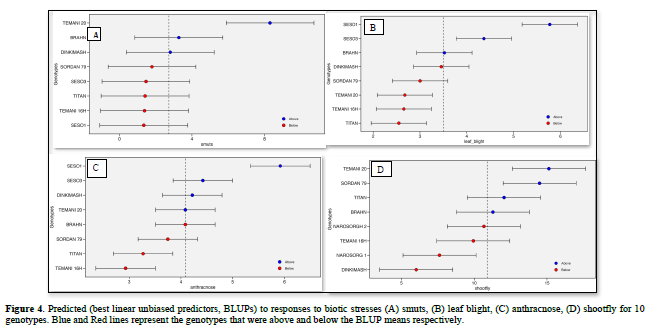
Stem borer response
Error variance was high, attracting 25.4% of total sums of squares with low C.V% of 19.98%. Genotype by Environment interaction was significant and contributed 21.9 % of total sum squares. Broad sense heritability (H) for low number of exit holes per stalk was high at 71.89% with very low correlation to grain yield loss. Average stem borer incidence was 7.5 %, indicating that the feeding damage was low perhaps due to recovery resistance or escape among some early maturity genotypes (Table 8). It is also possible that antibiosis and antixenosis resistance affected adversely larval feeding hence few exit holes. Therefore, in commercial sorghum hybrid production, there is need to adopt Integrated Pest Management (IPM) for stem borer with integration of host resistance and insecticide application when deemed necessary.

Shoot fly Reaction
Genotypic difference contributed to 75% of the genotype by environment interaction with high heritability of 90.65%. This perhaps relates to their genetic background and geographical area of origin. The difference in damages is perhaps also explained by differences in morphological traits i.e.; oviposition preference, recovery tillering, seedling vigor, glossiness and seasonal variation in insect populations. Differences in pest infestation could be conditioned by the following variables; management, genotype, location, and time of planting. These calls for integrated crop management strategies alongside using agronomically adapted genotypes to reduce damage from shoot fly. Therefore, training of farmers on proper agronomic practices is also important.
Response of genotypes to striga infection
Locations and genotypes were highly significant (p=0.001), with average striga count per plant at 1.53. However, there was no significant GxE effect giving a high C.V. =80.66%.due to high field variability as well as that from geographical regions (selected hot spot locations). Genotypes contributing too much of the variation were BRAHN and DINKIMASH with least severity in Namutumba and Iganga within the range 4.9 to 5.4 %, corresponding to score of 4 on 1-9 modified scale. This scale indirectly predicts some mechanisms of resistance to infection from the host side [16]. The resistant genotypes from this study perhaps have low strigol stimulation (Table 9). Sweet stalk sorghum hybrid cultivar SORDAN 97, had the highest infestation. This suggests that sorghum with high amount of sucrose in their stalk is more susceptible to striga infestation [17]. The relative magnitude of genetic effects was 6.5 implying significant genetic effects within locations. Broad sense heritability (H2) was 81.74% supports that resistance to striga is controlled by both dominance and additive gene effect [8]. Genotypes with additive gene effects possess more than one type of resistant mechanism [16]. Using such varieties tolerant to striga in the field, well adapted, with good organoleptic and agronomic attributes are beneficial to the farming community in striga endemic environments [18].
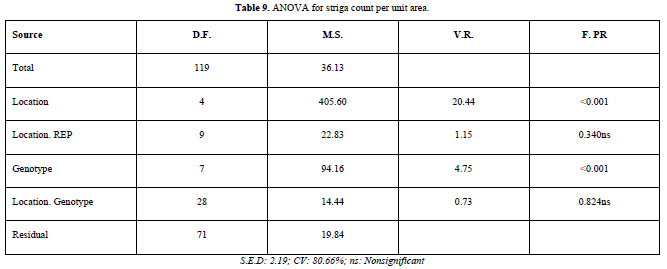
Turcicum Leaf blight response
Turcicum leaf blight response on 10 genotypes from combined analysis of variance over locations revealed significant genotype, environment and G * E interaction effect. The magnitude of G × E interaction was (47.7%) of total sums of square and magnitude of genotypic variation to G*E was > 2.5, implying greater genotypic effects with Broad sense heritability (H2) of 88.8%. Overall mean leaf blight disease score was 2.6 and three genotypes with lowest disease scores were; NAROSORGH 1(1.9), TEMANI 16H (1.7) and TITAN perhaps reflecting their genetic background (Figure 4B & Table 8). Management of Turcicum leaf blight within African agricultural system can best be achieved through the use of resistant varieties that have either qualitative and or quantitative resistance [19]. Genes with qualitative resistance being characterized by chlorotic and necrotic lesions without spore formation thereby limiting disease spread. The expression of genes corresponding to a virulence gene of the pathogen may be modified by environment [20]. Therefore, resistance exhibited by majority of the test entries from this study was mainly of quantitative in nature with fewer, smaller lesions and probably prolonged incubation period which makes them well adapted to sub-humid agro-ecologies [21].
Ranking of candidate sorghum cultivars based on Farmer’s preference
The information on participatory varietal selection (PVS) was summarized in a contingency (Table 10) and highlights farmer’s desire and preference in the selection of sorghum varieties for large-scale production and ultimate adoption [22]. Trait needing improvement is yield potential of the varieties which are early maturing. Farmer participatory ranking of the best variety was; TITAN (Table 11 & Figure 5). The groups were in very strong agreement related to earliness, yield, resistance to birds and attractive seed color with spearman’s correlation coefficient; p=0.806 (Table 11). Market research needs to be conducted to generate other silent quality features for improving development of target commercial products in future so as to drive the sorghum production value chain.
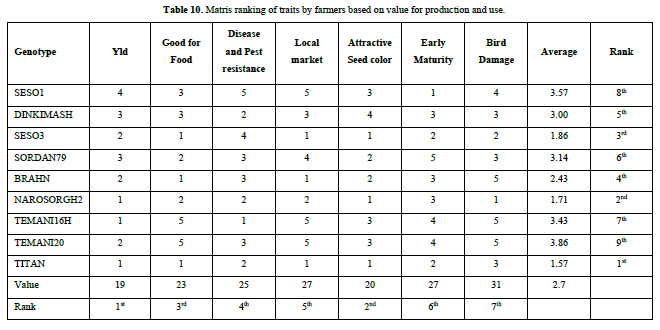
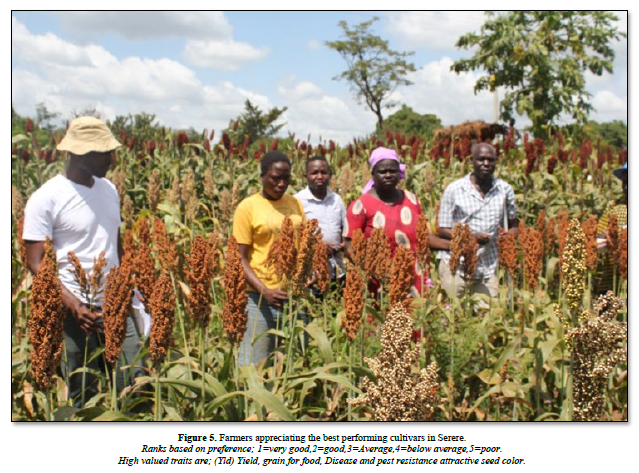
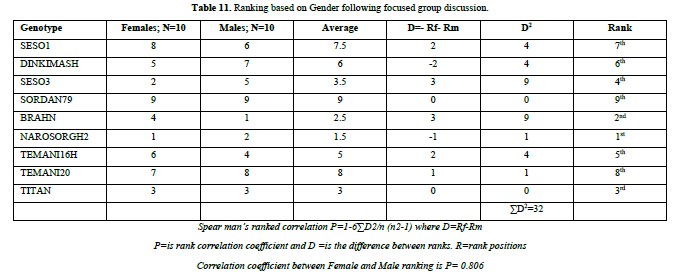
Agronomic characteristic and adaptation of candidate sorghum hybrids
TEMANI-16H (12GS9022) is a tan plant with cream grain color partly covered by brown glumes at physiological maturity. It is 100-120 cms high (semi-dwarf) with mid stout juicy stem. The mid-rib is cloudy in appearance and leaf angle is erect. The panicle is large (30-35cm), semi compact, erect, well exerted with glume pubescence present. It has mid-maturity period of 120-130 days after planting this makes it heavy yielder. It has general leaf disease resistance so can be grown in humid and sub humid environments, with stay green trait that makes it also suitable for drought prone areas in the semi-arid regions of the country. It has very low tannin with high malt extract and the kernel is starchy and yellow. The kernel threshes freely (Figure 6).
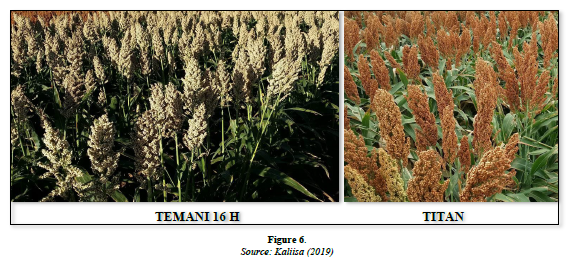
TITAN /KALIISA-21HR (12GS9051) is a highly preferred for its brick red to brown seed color good for food with relatively low tannin making it dual purpose variety. It is resistant to anthracnose and turcicum leaf blight so can be grown in humid and sub humid environments. It matures in 100-110 days after planting making it also suitable for dry land areas of Uganda because it can escape drought. The brick red color is ideal for various sorghum-based value-added food products. It is a short-pigmented plant of about 100-120 centimeters high with mid-stout juicy stem but not sweet. The Panicle is well exerted, semi-compact and cylindrical. The glume is dark tan and acute with pubescence. The glume is short in size (<25%), making the panicle to thresh easily.
CONCLUSION AND RECOMMENDATION
Based on the results the superiority of the candidate cultivars has been demonstrated. They meet specific local food and allied agro-industrial requirements. They have potential for high productivity, farmer preference in food and brewing value chains and nutrition agenda. Varieties are recommended for dry low lands and intermediate sub humid agro-ecologies. Thus, they should be recommended for registration in Uganda as; TITAN and TEMANI 16H to complement and supplement traditional open pollinated varieties. However, there is a need to integrate appropriate agronomic packages to maintain high productivity. Finally, to conduct market surveys to identify market traits that appeal to particular niche markets to promote development of commercializable products to drive production.
CONFLICT OF INTERESTS
The authors have not declared any conflict of interests.
ACKNOWLEDGEMENTS
The authors appreciate the AGRODYNAMICS INTERNATINAL SEED LIMITED for their financial support and providing materials for in conducting adaptation trials. Special gratitude to NARO-NaSARRI for conducting registration trials.
No Files Found
Share Your Publication :